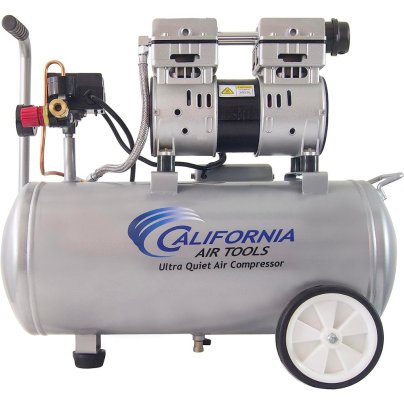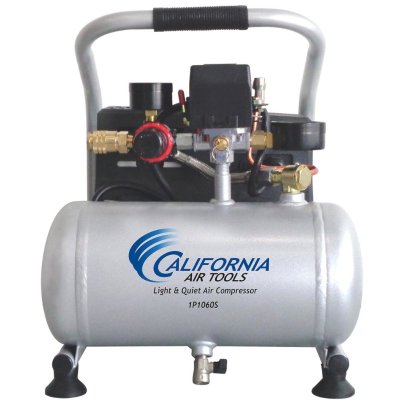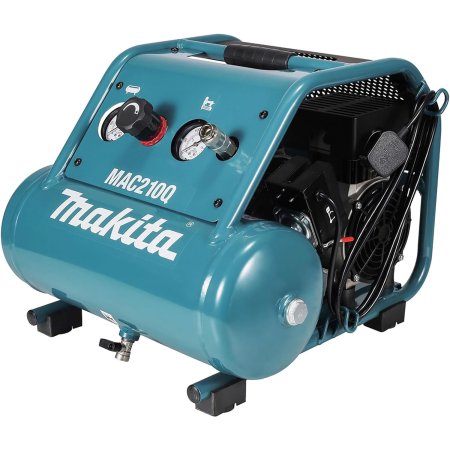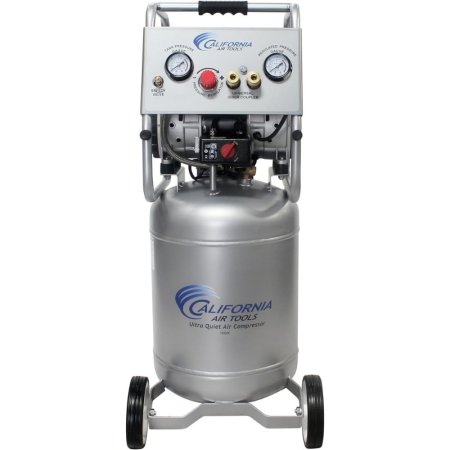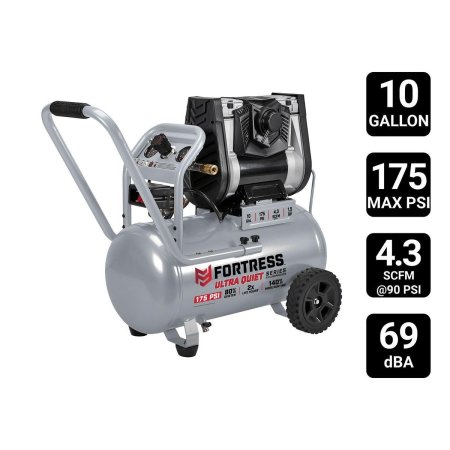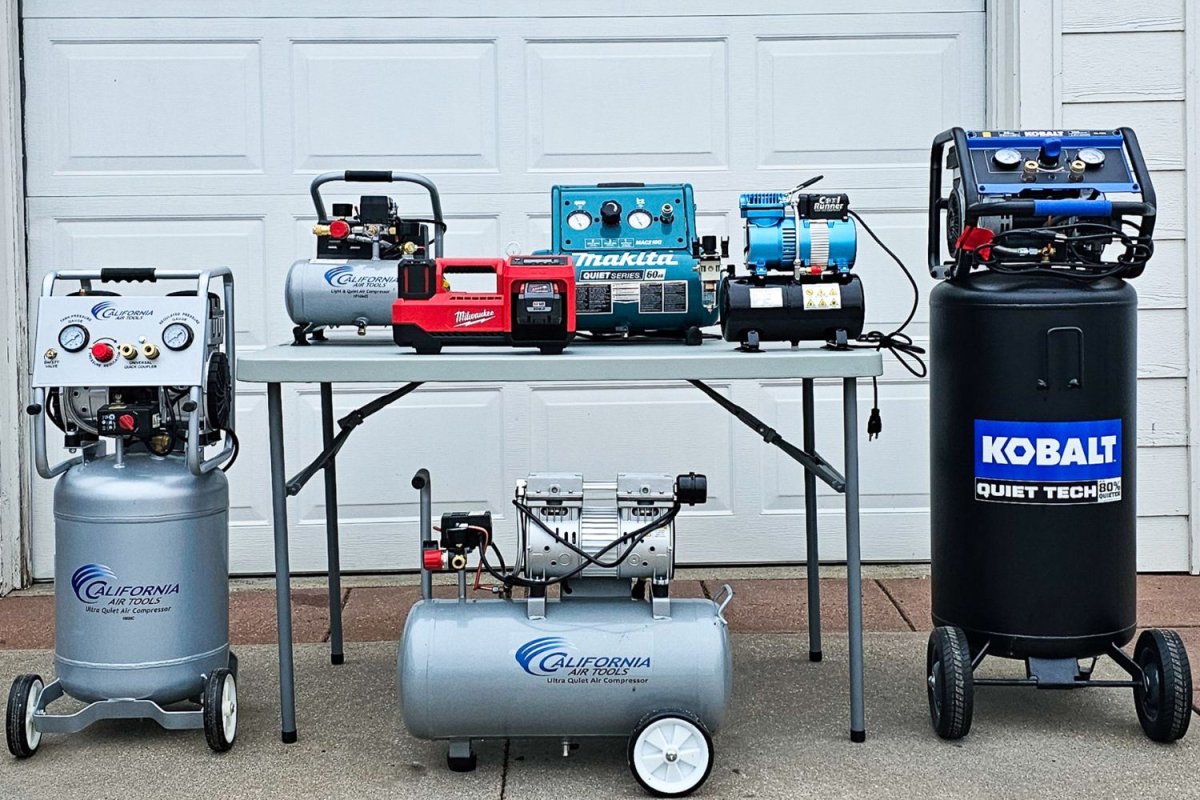
We may earn revenue from the products available on this page and participate in affiliate programs. Learn More ›
If you think air compressors are just tools for auto mechanics and housebuilders, think again. From inflating tires and balls to cleaning electronic devices, powering air tools, and painting, quiet air compressors can help make household chores easier.
When shopping for a quiet compressor, consider how you want to use it and look at the unit’s specifications. To help narrow the field, we tested some of the best quiet air compressors in our workshops and on jobsites. After all, a pneumatic tool is only as good as the air compressor powering it.
Keep reading to learn key shopping considerations and find out how the following models fared in our hands-on tests and earned a spot on our lineup of the best quiet air compressors.
- BEST OVERALL: California Air Tools 8010 1 HP 8-Gal. Air Compressor
- BEST BANG FOR THE BUCK: California Air Tools 1P1060S ⅗ HP Air Compressor
- BEST COMPACT: Makita MAC210Q Quiet Series 1 HP Air Compressor
- BEST FOR AIR TOOLS: California Air Tools 10020C 2 HP Air Compressor
- BEST FOR AIRBRUSH: Master Airbrush ⅕ HP Cool Runner II Air Compressor
- BEST MULTIPURPOSE: Harbor Freight Fortress 175 PSI Air Compressor
- BEST FOR TIRES: Milwaukee M18 18V Cordless Tire Inflator
- BEST HOME SHOP: Kobalt Quiet Tech 150 PSI 26-Gal. Air Compressor
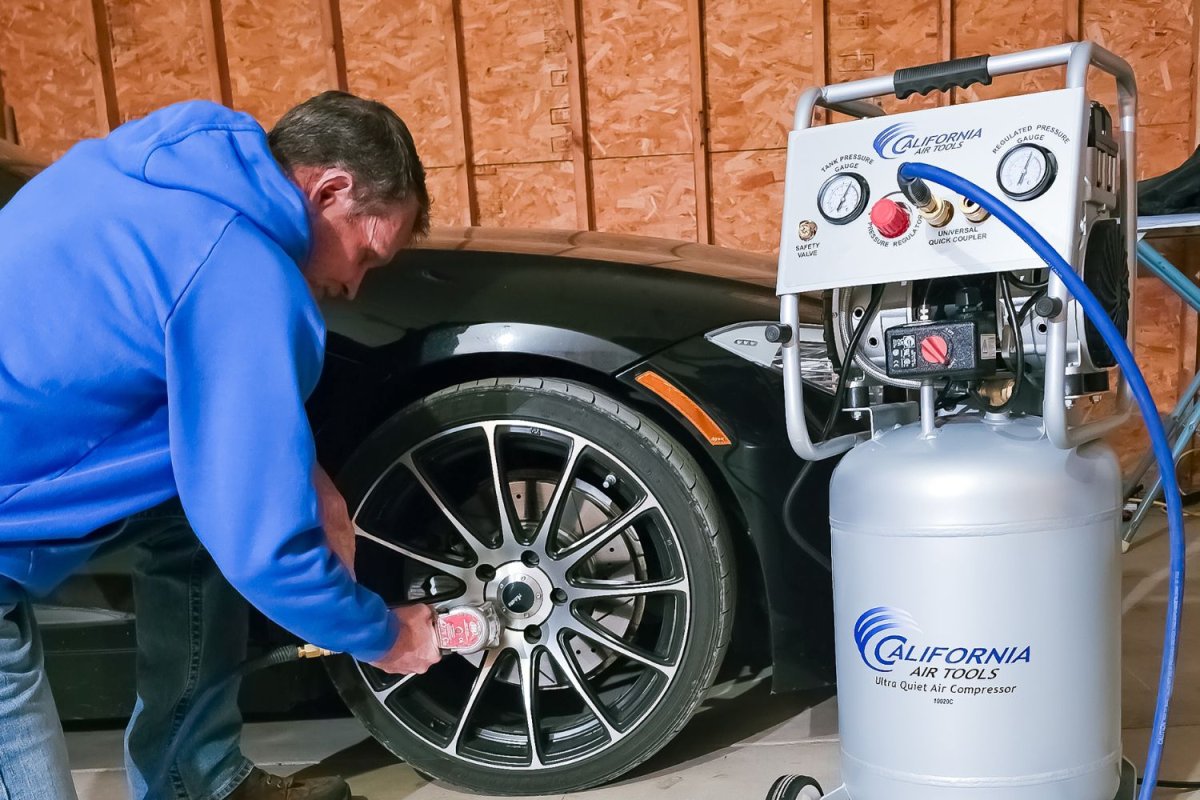
How We Tested the Best Quiet Air Compressors
With dozens of highly rated air compressors to choose from, it was a challenge to select the top performers for our hands-on tests. We considered brand names to an extent—after all, manufacturers such as California Air Tools are widely known for producing ultraquiet compressors, and other top manufacturers, such as Makita, have an extensive selection of air compressors, many rated as quiet.
After researching more than 35 air compressors, we narrowed our list by only considering models producing less than 75 decibels (dB) of sound intensity. That would be as quiet or quieter than a household vacuum.
When the compressors arrived, we assembled them and got to work. We connected air tools based on the compressor’s ratings and the tool’s pressure requirements and used the tools as we normally would on a project. We noted cycle run/recovery times and pressure consistency and used our decibel tester to verify the manufacturer’s stated noise level. Each compressor received points based on how it performed on each test. After testing, we averaged the points to determine our top picks and awarded each compressor a distinction based on its best use.
Testing Stats
- Products tested: 8
- Hours spent testing: 20+
- Tests performed: 5
- Price range: $140 to $400
Our Top Picks
The following list features the air compressors that performed the best in our tests while maintaining a noise level of less than 75 dB. You’ll find a variety of power levels and intended uses, but each one met our testing criteria, and at least one is sure to be a good fit for powering your pneumatic tools or devices.
Best Overall
California Air Tools 8010 1 HP 8-Gal. Air Compressor
Pros
- Quiet operation that is suitable for use indoors or in places with limited noise levels
- 8-gallon air tank has long runtime; enough for small to large projects
- Large wheels make it easy to transport or maneuver
- Suitable for various DIY tasks, from firing brads and staples to light-duty painting
Cons
- Not powerful enough to run high-capacity tools, such as impact wrenches or framing nailers
Product Specs
- Decibels: 60 dB
- Cubic feet per minute (CFM) at 90 pounds per square inch (PSI): 2.20 CFM
- Volume: 8 gallons
Our Ratings: Ease of Use 5/5; Power 4.5/5; Noise 5/5; Portability 4/5; Value 5/5
The California Air Tools 8010 is an ultraquiet air compressor that takes on projects like brad nailing, light-duty spray painting, blow cleaning, and inflating without disrupting the neighborhood.
The 8010 is rated at 60 dB of noise, but our tests registered just 50.6 dB, which is substantially quieter—like a voice from across a room. Either way, this is a nice, quiet air compressor.
It has an 8-gallon air tank, a 1-horsepower (hp) motor, and an oil-free pump. The only assembly we had to do was attach the large wheels, which took just a couple of minutes. The 8010 produces a steady flow of 2.20 CFM at 90 PSI, and we found it well suited for firing brad nails and staples and light-duty paint spraying. On a whim, we switched to heavy-duty paint spraying—but it ran out of steam during its recovery cycle. Still, we didn’t expect it to handle the load since it wasn’t designed to do so.
Its handle and wheels make it easy to pull this 48-pound hot dog–style compressor over uneven ground, and it’s low profile enough to store beneath a workbench. If you’re looking for a quiet all-around compressor, the 8010 deserves a close look.
Read our full review: California Air Tools 8010 1 HP 8-Gal. Air Compressor
Get the California Air Tools 8010 quiet air compressor at Amazon, Lowe’s, or The Home Depot.
Best Bang for the Buck
California Air Tools 1P1060S ⅗ HP Air Compressor
Pros
- Quiet operation generates just 56 decibels of noise, making it well suited to indoor projects
- At 29 pounds, the compressor is lightweight enough to easily carry where needed
- Despite its compact size, the air compressor powers brad nailers and construction staplers
- Recovers quickly, so there’s little to no downtime
Cons
- Not suitable for heavy-duty tasks that require high levels of continuous airflow
Product Specs
- Decibels: 56 dB
- CFM at 90 PSI: 1.20 CFM
- Volume: 1 gallon
Our Ratings: Ease of Use 5/5; Power 4.5/5; Noise 5/5; Portability 4/5; Value 5/5
Looking for a quiet air compressor that doesn’t cost a fortune? Check out the California Air Tools 1P1060S, which generates just 56 decibels of noise when it cycles on. This affordable compressor weighs just 29 pounds and comes with a 1-gallon steel air tank. In our tests, it was both easy to use and easy to carry.
When we unboxed the 1P1060S and powered it up, we were skeptical that a compressor as compact and quiet would stand up to anything more than airbrushing, but we were pleasantly surprised. The 1P1060S did a great job with our airbrush but also powered a brad nailer and a construction stapler and inflated the oversize tires on our truck.
This little California Air Tools marvel delivers 1.20 CFM at 90 PSI, and we were impressed at how quickly it recovered when we’d used enough pressure to trigger the recovery cycle—it took just 12 to 13 seconds for it to power back up to its maximum level at 120 PSI.
The 1P1060S isn’t designed to handle high-capacity pneumatic tools, such as impact wrenches or commercial spray guns, but it’s a star at delivering reliable power for smaller air tools. Best of all, it’s super quiet—making it a good pick for indoor use—and it comes at an attractive price point.
Get the California Air Tools 1P1060S quiet air compressor at Amazon, Lowe’s, or The Home Depot.
Best Compact
Makita MAC210Q Quiet Series 1 HP Air Compressor
Pros
- Measuring just 17.375 inches long by 16.875 inches wide by 13.625 inches tall, the tool won’t take up much storage space
- Relatively lightweight (45.2 pounds) coupled with a padded carry handle enhances portability
- This is a quiet air compressor, generating just 60 dB of noise
- Well suited for light to medium tasks, including brad nailing, stapling, and inflating
Cons
- Not enough power or large enough tank to run higher-capacity tools
Product Specs
- Decibels: 60 dB
- CFM at 90 PSI: 2 CFM
- Volume: 2 gallons
Our Ratings: Ease of Use 5/5; Power 5/5; Noise 5/5; Portability 4/5; Value 4.3/5
The compact Makita MAC210Q is easy to pack in a truck, carry around the worksite, and store in a garage. Perhaps best of all, it’s nice and quiet—making it well suited for workspaces where noise is a concern. It generates just 60 dB, comparable to the noise level of normal conversation.
We’re big fans of Makita power tools, and the MAC210Q lived up to the brand’s high reputation. We tested it by firing brads in hardwood trim boards and shooting construction staples in plywood sheeting. We also tried it with our airbrush, although this is oversize for airbrushing. It provided ample power in all our tests and had a quick recovery time, so we didn’t have to stop firing brads or staples during its recovery cycle.
It weighs 45.2 pounds and comes with a padded top handle, while its slim profile makes it more comfortable to carry. It delivers 2 CFM at 90 PSI, so it’s not powerful enough to run higher-capacity tools such as impact wrenches. It also has a sturdy roll cage that protects the motor from accidental drops or falls, and at just 17.375 inches long by 16.875 inches wide by 13.625 inches tall, it won’t take up too much storage room.
Get the Makita quiet air compressor at Amazon, The Home Depot, or Ace Tool.
Best for Air Tools
California Air Tools 10020C 2 HP Air Compressor
Pros
- Sufficient air pressure to run most garage tools, including impact wrenches and die grinders
- 2 connection ports allow 2 different tools to be powered simultaneously
- Produces just 70 dB of noise during its recovery cycle
- Comes with sturdy wheels and a handle that make it easy to move around
Cons
- May not have enough power to run high-capacity paint spray guns
Product Specs
- Decibels: 70 dB
- CFM at 90 PSI: 5.3 CFM
- Volume: 10 gallons
Our Ratings: Ease of Use 5/5; Power 4.5/5; Noise 5/5; Portability 4/5; Value 5/5
Go ahead and ratchet up the power with the California Air Tools 10020C air compressor. With a 10-gallon heavy-duty steel tank, a 2 hp motor, a maximum pressure of 125 PSI, and 5.3 CFM at 90 PSI, this unit offers ample power for running common garage tools, including impact wrenches, die grinders, and more.
Several aspects of the 10020C made it a winner in our tests. We were able to run two pneumatic tools at the same time thanks to the compressor’s two connection ports, and the compressor produced enough power to run all of our pneumatic auto tools except our largest impact wrench—which wasn’t a surprise, since it’s designed for removing the lugs from the wheels of big rigs. The 10020C easily powered our standard impact wrenches and sailed through our framing nailer tests. It also successfully powered our mid-duty paint sprayer, but it wasn’t quite enough for our high-capacity commercial sprayer.
With all that power, we were pleasantly surprised that the compressor produced just 70 dB during its recovery cycle. This makes it an excellent choice in a garage where sounds can reverberate and seem even louder than they are. It has enough power to run most air tools used by home mechanics and comes with sturdy wheels and a handle that make it easy to roll it from spot to spot.
Get the California Air Tools 10020C quiet air compressor at Amazon, Lowe’s, or The Home Depot.
Best for Airbrush
Master Airbrush ⅕ HP Cool Runner II Air Compressor
Pros
- The compressor is very quiet, generating just 40.8 dB in our tests
- Excellent choice for precision airbrushing jobs where consistent pressure is vital
- Quick pressure buildup, reaching max pressure levels in about a minute
Cons
- Not suitable for use with standard DIY power tools that require higher capacity
- May have been a fluke, but we ran into a loose connection and had to tighten it
Product Specs
- Decibels: 47 dB
- CFM at 90 PSI: 0.8 CFM
- Volume: 0.8 gallons
Our Ratings: Ease of Use 4.5/5; Power 5/5; Noise 5/5; Portability 5/5; Value 4.7/5
Working on projects that demand a high level of precision, such as airbrushing, takes intense focus and concentration, and the last thing you want is to be startled by an air compressor cycling. Enter Cool Runner by Master Airbrush—a compact little air compressor that generates just 47 decibels, according to the manufacturer. In our tests, the Cool Runner generated just 40.8 decibels while it was cycling. Either way, it’s very quiet.
We loved using the Cool Runner in our airbrush painting tests. It comes with a maximum 57 PSI—not enough to power any type of DIY tools, but ample enough for airbrushing. It reached maximum pressure about a minute after we turned it on, but while preparing to attach our airbrush (not included), we noticed the pressure level on the gauge dropping. There was a leak somewhere, though we couldn’t hear or feel it. We sprayed a little dish soap water on the connections and one started bubbling. We tightened that nut with a wrench and had no more leaking issues.
Other than that, the Cool Runner was a star performer in the quiet, low-volume compressor category. It delivered consistent pressure for our airbrush and we worked for 5 minutes before it cycled on. We were still able to work during the cycle recovery period, making the Cool Runner a good choice for airbrushing when you can’t afford to stop and wait for your compressor to finish cycling.
Get the Master Airbrush quiet air compressor at Amazon or Walmart.
Best Multipurpose
Harbor Freight Fortress 175 PSI Air Compressor
Pros
- Quiet start-up and operation compared to traditional air compressors
- Well suited to several tasks, including nailing, inflating, and blow cleaning
- Never-flat tires don’t need to be filled up before rolling the unit
Cons
- Relatively heavy at 83 pounds, but rolling is manageable thanks to handle and wheels
- Not a quick-recovery compressor but still more than sufficient for many pneumatic uses
Product Specs
- Decibels: 69 dB
- Standard cubic feet per minute (SCFM) at 90 PSI: 4.3 SCFM
- Volume: 10 gallons
Our Ratings: Ease of Use 4.5/5; Power 5/5; Noise 5/5; Portability 5/5;Value 4.7/5
Powerful air compressors are often earsplittingly loud, capable of startling nearby workers and sending pets running. Thankfully, Harbor Freight’s 10-gallon Fortress model offers both power and quiet operation.
This air compressor generates 69 dB when cycling, which is comparable to a vacuum cleaner at about 10 feet away. We were pleasantly surprised at how little noise it produced for the amount of power it gave us. We tested it by firing multiple brads, nails, and staples into hardwood and plywood, and it didn’t miss a beat. It wasn’t quite powerful enough to run our commercial paint spray gun, but it came close—though we weren’t disappointed because that was pushing it a bit too far anyway. It did great with our light-duty paint sprayer.
The Fortress is a good choice for a portable air compressor thanks to its oversize never-flat tires and sturdy handle for rolling, but it would also be a standout in a garage or workshop. It delivers 4.3 SCFM at 90 PSI. This measurement is similar to CFM but factors in temperature and air density, making it slightly more accurate.
It also offers a maximum pressure of 175 PSI, so it’s suitable for many DIY tasks. Indoors or out, the Fortress delivers a good deal of air power without creating a lot of noise.
Read our full review: Harbor Freight Fortress 175 PSI Air Compressor
Get the Harbor Freight quiet air compressor at Harbor Freight.
Best for Tires
Milwaukee M18 18V Cordless Tire Inflator
Pros
- Powerful enough to inflate pickup tires as well as car and bike tires and basketballs
- Compatible with Milwaukee M18 rechargeable batteries (not included)
- Stores selected pressure settings in memory for easy use
- Shuts off automatically when desired pressure in the tire is reached
Cons
- Requires a separate purchase of M18 battery and charger, as they are not included
Product Specs
- Decibels: Not listed (56 dB in testing)
- CFM at 90 PSI: Not rated at 90 PSI (1.10 SCFM at 35 PSI )
- Volume: Not applicable (pump only)
Our Ratings: Ease of Use 4.5/5; Power 5/5; Noise 5/5; Portability 5/5; Value 4.5/5
Small inflators are great for airing up basketballs, bike tires, and car tires, but they don’t always have enough pressure to fill pickup truck tires. That’s not an issue with the Milwaukee M18 inflator, which aired up our truck tires without a problem. The manufacturer doesn’t list the noise level, but it registered 56 on our decibel tester, making it suitable for inclusion as a quiet compressor.
The Milwaukee doesn’t have a pressurized air tank—instead, it features a robust pump that forces compressed air through the air compressor hose and into the tire. This little compressor gets a power boost from a Milwaukee M18 rechargeable battery, although it’s not included. If you already own cordless M18 Milwaukee power tools, their batteries will interchange with this inflator. Runtime will depend on the capacity of the battery you use.
The feature we liked best on the Milwaukee inflator was the option to inflate tires to a preset pressure. It comes with a digital screen and scroll buttons that allowed us to select the pressure we wanted. The inflator shuts off as soon as the pressure is reached. Plus, the unit stores the selected pressure in its memory so we could scroll through and quickly select it again.
Like all Milwaukee tools, this inflator is built to last—it’s made from impact-resistant materials and even an accidental fall from our truck bed didn’t phase it. If you’re looking for an on-the-go inflator that can handle pickup tires, don’t miss this one.
Get the Milwaukee M18 quiet air compressor at Amazon or The Home Depot.
Best Home Shop
Kobalt Quiet Tech 150 PSI 26-Gal. Air Compressor
Pros
- Generates just 70 dB, making it a good pick for shops where noise is a concern
- Capable of powering most pneumatic tools, including nail guns, impact wrenches, and spray guns
- High airflow of 4.5 CFM at 90 PSI offers consistent power
- Large 26-gallon tank supplies ample air for extended use
Cons
- At 125.66 pounds, it may be difficult to load and unload from a truck bed
Product Specs
- Decibels: 70 dB
- CFM at 90 PSI: 4.5 CFM
- Volume: 26 gallons
Our Ratings: Ease of Use 4.7/5; Power 5/5; Noise 5/5; Portability 4/5;Value 5/5
If you’re searching for an air compressor to power several types of nail guns, impact wrenches, and even pro-quality paint sprayers, look no further than the Kobalt Quiet Tech 26-gallon compressor.
This is a serious shop compressor that weighs 125.66 pounds—so loading it on a truck bed might be challenging, but thanks to oversize tires and a handle, pulling it around our shop was a breeze.
We’re used to shop compressors that emit earsplitting roars when they cycle on, so using the Kobalt, which generates just 70 dB, was a treat. With its large 26-gallon tank, 4.5 CFM at 90 PSI, and a maximum PSI of 150, this Lowe’s brand compressor is a powerhouse.
We tested a framing nailer, an impact wrench, a belt sander, and a high-capacity paint spray gun on the Kobalt compressor, and it didn’t miss a beat. We still had ample airflow even during its recovery cycle.
The Kobalt Quiet Tech is an excellent home air compressor for woodworking and auto repair where the user needs consistent airflow while maintaining a relatively quiet atmosphere.
Get the Kobalt quiet air compressor at Lowe’s.
Jump to Our Top Picks
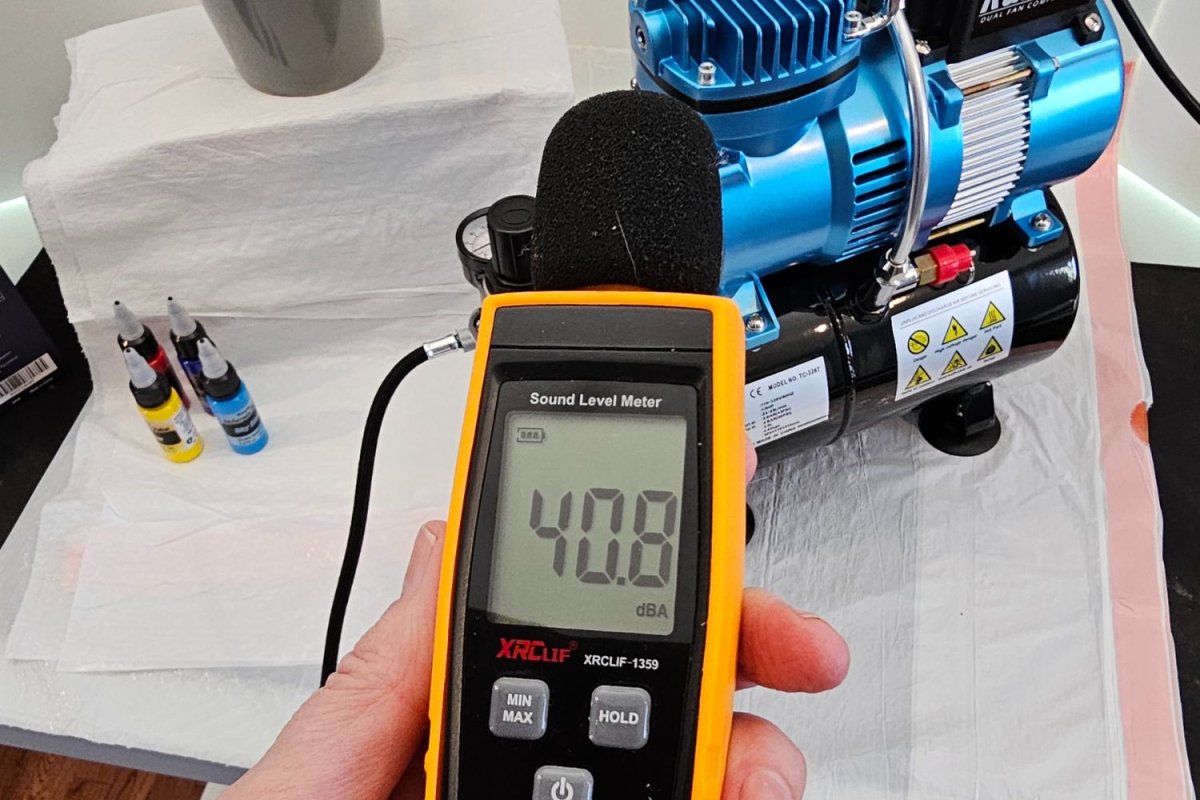
What to Consider When Choosing a Quiet Air Compressor
The decibel level is a primary consideration when shopping for a quiet air compressor, but type and performance also matter. To get the greatest return on your investment, think about how you might use it and match the type of air compressor and its various specifications to those tasks.
Compressor Type
There are five main types of compressors: inflator, pancake, hot dog, twin stack, and single stack.
- Inflators are small, lightweight, and tankless. They are usually stored in a vehicle for inflating tires and toys.
- Pancake compressors have a 1- to 6-gallon tank, are maintenance-free, are good for inflating tires, and have limited use with small air tools.
- Hot-dogcompressors have a 6- to 10-gallon tank, are maintenance-free, and are good for operating small air tools.
- Twin-stackcompressors have dual air tanks, are low maintenance, and are good for powering finish and trim tools.
- Single-stagecompressors have a 10- to 20-gallon-plus tank with a vertical construction. They are available as wheeled and stationary configurations and have heavy-duty components for higher usage: framing, woodworking, and automotive use.
Noise Level
Most air compressor noise ratings range from 40 to 92 dB, with quiet types ranging around 50 to 70 dB. To provide some context, 30 dB is equivalent to a whisper, 60 dB is the level of normal conversation, and a gasoline-powered lawn mower is usually about 90 dB.
Entry-level single-piston compressor pumps are typically loud, whereas similarly designed units made with higher-quality materials create less noise. The motor’s noise level, caused by friction, is affected by the pump design and the material of the components.
Double-piston, or duplex, pumps are more efficient and even less noisy because they move less to create the same amount of compressed air. Other noise-reducing solutions to watch for include cast-iron pistons, low revolutions per minute, and American Society for Mechanical Engineers (ASME)-certified air tanks.
Performance
An air compressor’s working ability is shown by three key measurements: horsepower, air pressure in PSI, and airflow capacity in CFM.
The horsepower rating shows both the motor’s strength and the unit’s overall efficiency. With higher-quality materials, better design, and tighter construction tolerances, it is possible to gain more overall capability while horsepower stays the same. The engine power is used to pump air into the tank. Most consumer-grade quiet air compressors fall in the 1.5 to 2.0 hp range because more powerful electric motors cannot use a standard household wall outlet.
To work properly, most air tools require 90 PSI. Required airflow capacity ranges from about 2.0 to 5.5 CFM, depending on the tool. If multiple tools will be used simultaneously, total the CFM requirements of all tools to determine the CFM rating that the air compressor needs to perform all of the tasks.
Number and Size of Tanks
Quiet air compressors come with one or two air tanks ranging from less than 1 gallon to more than 20 gallons in size. Twin-stack air compressors incorporate two smaller air tanks rather than one larger tank as a space-saving way to increase available air volume.
As compressed air is released from the tank to operate tools, the pressure inside the tank gradually decreases. The drop in pressure triggers the pump to draw in more air. This is called recovery.
Although a larger air volume means a longer fill time, more air means you can operate tools for longer intervals without triggering the pump to refill the tank. This is especially important when working with high-demand air tools like paint sprayers, sanders, and grinders or when waiting for the pressure to recover is not feasible.
Power Source and Portability
Some large commercial-grade air compressors use diesel fuel, gasoline, or hardwired electrical service as a power source. For example, the largest-capacity compressors can require hardwiring on a heavy-duty circuit. Small, portable inflators may be powered by batteries or automobile outlet adapters. Battery-powered compressors offer limited capability for light-duty work.
However, most of the quiet air compressors used by construction professionals and DIYers, including the models in our roundup, are powered by readily available 110-volt electrical service. A standard household outlet or a portable generator supplies the needed current. For best results, manufacturers recommend using a heavy-duty extension cord.
Along with the power source, the compressor’s configuration affects its portability. Vertical hand truck–style construction works well for space-saving applications, such as garage use, while facilitating movement around the flat, smooth floor. Compact portable units for outdoor and off-road work may be built with a top handle and no wheels, making them easier to hand carry, or in a horizontal configuration with one or two wheels for wheelbarrowlike transportation.
Oil-Lubricated vs. Oil-Free Pump
In order to protect the air pump’s internal moving parts from the damaging effects of friction and heat, engineers use either of two methods.
Oiled lubricated compressors incorporate a rotating dipper system to splash oil from a reservoir onto the moving parts. They are mostly large, stationary machines used for daily professional applications. They operate at higher revolutions per minute to deliver higher CFM and PSI to meet the demands of constant tool use.
Oil-free air models are mostly small, lightweight, and portable air compressors for on-demand use by DIYers, contractors, and building professionals. They are typically used to power one or two tools at a time. They are quieter, more efficient, and work well in colder temperatures. Oil-free compressors use a permanent wear-resistant chemical coating that is designed to last the life of the pump.
FAQs
After reading up on the recommended shopping considerations and checking out the results of our hands-on tests, you may still have a few questions. Ahead are some of the most common questions shoppers ask about quiet air compressors.
Most quiet air compressors available to consumers are high-efficiency dual-piston pump types. They are engineered to exact tolerances and operate at lower revolutions per minute to pressurize more air with less movement, which makes them quieter overall. Typically, 60 dB is considered among the quietest, and we tested several options, including the California Air Tools 8010 quiet air compressor.
Most of the noise associated with air compressors is associated with the intake. For those who want to know how to make an air compressor quiet, simply install an air compressor intake silencer.
Overall air compressor dB ratings range from as low as 40 dB for some small, specialized types to more than 90 dB. Quiet air compressors operate in the 70 to 80 dB range, while ultraquiet air compressors operate at 60 dB.
An air compressor muffler, or silencer, is a noise filter that can be installed on the air intake to reduce noise.
Yes, you can find several. Although we didn’t test it, the 20-gallon California Air Tools 20020A quiet air compressor operates at 70 dB.
Don’t be confused by tank size. Some tools work with less than 2.5 CFM, but others need as much as 5.5 CFM to function properly, regardless of tank size. Air tools are powered by airflow (CFM) at 90 PSI, so start by looking for and comparing that spec.
Air tools that utilize quick bursts of air, like nailers, function just fine on smaller tanks, especially if the tank holds higher pressure (higher air pressure equals more air). After ensuring adequate CFM airflow for your tools, a larger tank simply provides more runtime before recovery. All that being said, a good starting point for low-demand air tools would be 2 gallons. For high-demand tools, 8 to 10 gallons would be better.
Install a muffler, or silencer, to quiet a loud air compressor.
Meet the Tester
Glenda Taylor is a product tester and writer specializing in the construction, remodeling, and real estate industries. She and her husband own a general contracting company, and Taylor is experienced in both residential and commercial building applications. She tests a wide range of power tools and other home improvement, household, and lawn-and-garden products.
Additional research was provided byMark Wolfe.
